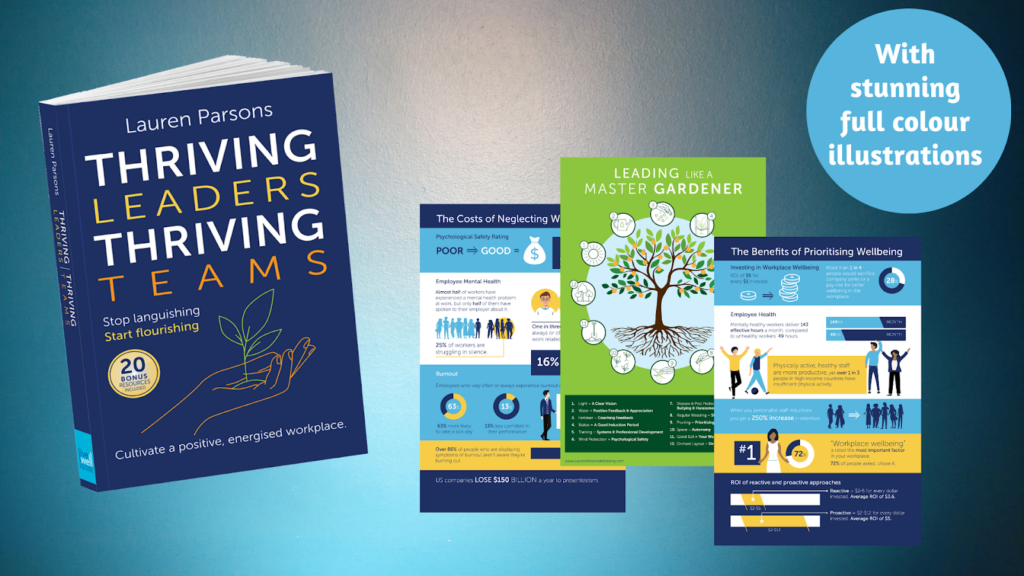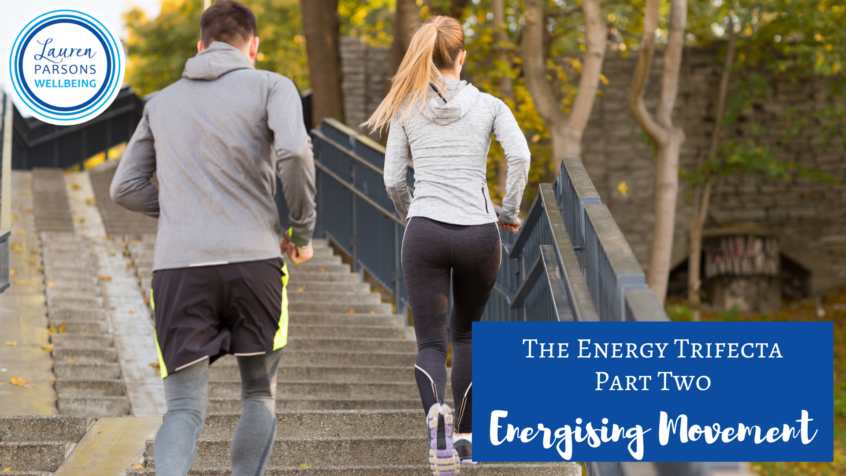An excerpt from Lauren Parsons book ‘Thriving Leaders Thriving Teams’.
To have great energy, the three most important fundamentals are (1) great nutrition, (2) energising movement and (3) sound sleep.
I often help leaders create a more energised workplace culture by focusing on these three things and the wide range of ways you can influence them. We still so many workplaces where people face the challenges of being:
- Poorly nourished.
- Less active.
- Lacking quality rest.
We’ve already looked at how to improve your nutrition culture in Part One of this series. Now let’s look at how to create an energised workplace team.
LESS ACTIVE
The human body is designed to move. If we could bottle the incredible life-giving benefits of exercise, it’d be absolutely priceless. As I mentioned in Chapters 5 and 6, exercise can be a powerful antidepressant, intelligence enhancer, energy booster and fountain of youth. Not only do active people reap long-term health benefits and live longer, they also have more energy and better cognitive horsepower at work.
Numerous studies show physically active staff are more productive and absent less frequently than those who are largely inactive. Employees who get at least 75 minutes of vigorous physical activity per week have, on average, 4.1 fewer sick days per year. Picture your colleagues who head out for their 25-minute lunchtime run Monday, Wednesday, Friday and remember to thank them for their efforts. They’re adding to your bottom line.
As a society, we’re much less active than we used to be. Labour-saving devices have removed a lot of manual tasks, making it fairly easy to go through our days without getting our heart rate up, unless we’re intentional about it. An increase in knowledge workers means more and more people are in computer-based roles and feel shackled to their desks and screens. Even for those who don’t have a sedentary job, smart devices, social media and unlimited movie streaming often reduce the time people spend outdoors being active.
As we discussed in Chapter 5, ‘snacking on exercise’ is all it takes to boost your brain, body and mood. The mental health lift is potentially the most important benefit from adding micro-movement into your work day. As it’s been said, “You’re only one workout away from a good mood.” You can elicit an instant change in your body’s biochemistry by getting your heart rate up, which takes only seconds. Not only does it make you feel great, it also improves focus, clarity of thought and helps you come up with better, more innovative ideas.
There are so many ways to make it the norm for your team to be active to, from and during the workday.
HOW TO BOOST YOUR ENERGY AND VITALITY
IDEAS FOR LEADERS
- Provide safe and secure bike parking facilities to encourage active commuting.
- Consider issuing staff with bikes or subsidising them.
- Host a basic bike mechanic course.
- Have suitable bathroom facilities onsite so people can shower and change before work or during the day.
- Rethink uniform policies if they’re not conducive to staff being active. (Do women really need to wear high heels? They’re not recommended ergonomically, especially if using a standing desk.)
- Offer flexibility on break times so people can, for example, start 20 minutes earlier and take that extra time in their lunch break to get outdoors for a run.
- Set up an onsite workout space. You don’t need bulky or expensive equipment to do so. Hand weights and resistance bands can be effective, along with a big screen to stream guided bodyweight workouts from reputable trainers.
- Create a walking loop track if you have the space on your property or create a map of local walks.
- Set up a ping-pong table, basketball hoop or four-square court. Encourage camaraderie and a bit of friendly competition.
- Start a walking club. For example, a daily 10-minute brisk walk mid-morning, or a longer loop at lunchtime on set days.
- Recognise and reward those who are active. Have a simple way to track how often people get out for those walks and create a leader board.
- Run mini-challenges at set times of the year such as a step challenge, bike-to-work challenge, or lunchtime run/walk challenge with team prizes to encourage widespread participation.
- Have your IT team set up on screen reminders to take stretch breaks or movement breaks.
- Educate staff on short effective stretch routines and ways to snack on exercise. This could be a mix of in-person training sessions, videos and posters to give them ideas.
- Have a daily dance party. Let staff members take turns picking the song.
- Introduce the little golden bell. A different person gets the bell on their desk each day and chooses when to ring it, as the signal for everyone to get up for a 60-second deskercise break.
- Have adjustable desks and encourage staff to do a mix of standing and sitting. Even without adjustable desks people can create new habits by choosing to stand up for certain tasks, like phone calls or while reading their emails.
- Have bar leaner height desks in meeting rooms with tall chairs so people can choose to either sit or stand during meetings.
- Initiate walk and talk meetings.
- Enter staff teams in local social sporting leagues.
- Sponsor staff teams or individuals in multisport events and fun runs and provide the flexibility for staff to train for them during their workday.
- Rather than only offering to subsidise gym memberships, broaden this to include things like martial art classes, geocaching, trampolining or other active pursuits. You could even sign interested team members up to the same dance class or mountain biking course, creating opportunities to build connection while being active together.
IDEAS FOR INDIVIDUALS
- Learn how to Snack on Exercise and check out the Facebook page for plenty of ideas of ways to add energising movement into your day and encourage those around you to join in.
- Use the 101 minute cycle, including the movement breaks, which I explained in Chapter 7.
- Link movement breaks to common tasks to remind you throughout the day. For example when you brush your teeth; every time you send a text message or email; each time you return to your desk.
- Use a movement tracking watch or app to motivate you to be consistently active.
- Be the initiator and invite teammates to join you for a walk or a game of ping pong, basketball or four square, especially mid-afternoon when most people feel lower in energy.
- Use the bathroom at the far end of the building on another floor.
- Make it your default to commute to and from work and to do errands by walking or biking whenever possible. Drive in once a week to drop off clothes if needed, or if you have secure parking you can alternate between cycling and driving to facilitate this.
- If you live too far to cycle, park a few blocks away and walk the remainder. Leave ‘work shoes’ at work to change into once you arrive.
Refer back to Part One of this series here and read on for Part Three of this article series, where we look at how to improve your mood, memory and energy through deep restorative sleep.
Enjoyed this article?
To find out more about creating a positive, energised workplace culture read the whole Thriving Leaders, Thriving Teams book. Order your copy today here.
Complete will full colour, full page illustrations, it’s a fantastic guide to help you stop languishing and start flourishing.

“An extraordinarily powerful book with an inspiring mission at its heart. If you want to cultivate and sustain the right conditions for your team and workplace culture to flourish, this book is your guide, your support and your inspiration”
– Steven Hargreaves, Author of The Compassionate Leader’s Playbook
“Thriving Leaders, Thriving Teams makes a compelling case for fostering wellbeing in the workplace and is full of practical tools and ideas for both individuals and leaders on how to do this.”
– Suzi McAlpine, Author of Beyond Burnout
A must-have for all leaders. Comprehensive, practical and easy to read!
– Karen Tui Boyes, CEO
About the Author – Lauren Parsons, CSP, AS
Lauren is a keynote speaker, author and consultant who’s passionate about helping busy people discover little-used techniques to boost their energy, vitality and performance. She’s the only speaker in the world to focus on lifting BOTH workplace wellbeing and productivity.
Awarded NZ Keynote Speaker of the Year and Educator of the Year 2023/24 by the Professional Speakers Association. Lauren is a sought-after international speaker, one of only a dozen Certified Speaking Professionals and the only Accredited Speaker in New Zealand.
TEDx speaker, Author of Thriving Leaders Thriving Teams and Real Food Less Fuss, Founder of the Snack on Exercise movement and host of the Thrive TV Show. With over 20 years’ experience, Lauren integrates her wellness and business background to help leaders find the sweet spot between boosting both wellbeing and productivity.
Described as unforgettable and life-changing, Lauren is a dynamic and highly-engaging presenter, and master story-teller who will have you laughing, moving and learning in a memorable way. Whether it’s virtual or in-person, you will leave Lauren’s session feeling uplifted and empowered to create positive change, today!
Based in the Manawatu, New Zealand, where she lives with her husband and three children, Lauren can often be found hosting dinner parties, playing board games, running, reading or getting out in her gumboots to walk the paddocks. She travels regularly to speak at conferences and in-house and specialises in helping leaders create positive, energised workplaces where people thrive.
Check out all the goodness at Lauren’s “Free Stuff” page at www.LaurenParsonsWellbeing.com

Ways to connect with Lauren
- Find out about conference keynotes
- See her most popular topics
- Make a time for a virtual cuppa over zoom
Share this Post
